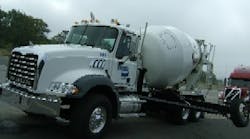“Full-stability technology works, it‘s affordable, and it will help us continue our track record as an industry leader in accident reduction.” -Jeff McCaig, chairman, Trimac Transportation
You‘ll be hearing about Bendix Commercial Vehicles Systems LLC a lot this week. The company is not only playing host to John H. Hill, head of the Federal Motor Carrier Safety Administration (FMCSA), for a speech he‘s giving on the U.S. Department of Transportation‘s new plan for reforming the federal approach to the nation‘s highway and transit systems, but is also releasing a new white paper - entitled “Road Map for the Future” - that touts the safety benefits of advanced safety systems, such as its electronic stability program (ESP).
(A concrete mixer test truck equipped with Bendix's full stability control package.)
More than a few commercial fleets decided to add Bendix‘s stability control package to their trucks, with bulk commodities carrier Trimac Transportation being the latest back in May to green light this technology for its Kenworth tractors.
And as Jeff McCaig, Trimac‘s chairman, noted above, the reasons are very compelling for buying such systems just from the monetary standpoint alone. That‘s because U.S. government studies show that vehicle accidents involving injury can cost an average of more than $200,000 per event, while the cost of accidents involving fatalities can average more than $3 million per incident.
Yet Bendix - like its competitor ArvinMeritor, which offers similar safety systems - is finding full-stability control technology and new air disc brakes, designed to vastly reduce the stopping distances for tractor-trailers, remains a tough sell.
I bumped into one such reason earlier this year at an ArvinMeritor safety demonstration, where a fleet manager literally had to bribe his insurance agent with a round of golf in sunny Florida to get him to witness the potential benefits these kinds of technologies can provide - the greatest being not only the reduction in accidents, but in their severity as well. Yet it is still proving to be a tough sell to the insurance industry - giving fleets discounts based on their adoption of safety systems.
(A compelling Bendix braking demonstration showing the benefits air disc brakes offer in terms of shorter stopping distances.)
Why is this? Insurance companies should be able to see the benefit these systems bring to the table for truckers. I‘ve included several clips from Bendix that show how stability control systems plus new brake designs improve vehicle handling and maneuvering in emergency situations. For without some sort of incentive, fleets are hard pressed to commit ever-scarcer dollars to adopt these technologies.
A telephone survey conducted by FMCSA back in August 2003 with 19 different fleets - both private and for-hire - starkly illustrated that conundrum.
The three most important safety technology issues for the motor carriers FMCSA interviewed were the accuracy and reliability of the system, the cost to install and maintain the technology, and proven effectiveness to improve safety. Calculating a return on investment (ROI), in particular, stayed uppermost in the minds of most of the carriers, according to FMCSA‘s survey.
(This fast-moving Bendix video shows how stability control improves the handling of tractor-trailers, vocational trucks, even buses, in all sorts of bad weather.)
“ROI is a factor unique to carriers, but almost all carriers emphasized its importance in their deciding to adopt on-board safety technology,” the agency reported. “They want quantifiable data on costs and benefits. One carrier presented the following scenario: To install an $800 item into a fleet of 3,000 vehicles, costing $2.4 million, requires breakeven payback in six to eight months - and there must be ongoing payback as well. Other carriers stated that they looked for payback in the 12 to 18-month timeframe. None indicated a payback greater than 24 months as being acceptable.”
A wrote a story about this issue a few years back and talked with David Melton, director of transportation technical services for insurance firm Liberty Mutual, to get some insight as to what‘s holding things up.
“Payback analysis in terms of [truck] safety systems isn‘t so much a science but an art form,” he told me. “That‘s because the biggest problem is that payback analysis misses the entire point. In order to calculate payback by traditional means, you only look at crash costs and these are ‘lagging indicators‘ - you‘re waiting for something bad to happen so you can justify the investment.”
The real key to payback analysis, said Melton, is to measure changes in driver behavior: what is and is not occurring behind the wheel. “In this case, you do not get the bottom line figures business owners want to see, but you are doing something far more important: you are lowering your level of risk,” he noted. “Because as the level of safe driver behaviors go up - slower speeds, greater following distance, less aggressive braking - the severity and frequency of crashes go down. That must be included in your payback analysis in addition to measuring reduced crash costs.”
(The outriggers you see on these test trucks prevent rollovers from occuring when the Bendix stability control systems are turned off.)
Still, one would think after looking at the videos I‘ve included here that fleets and their insurance providers could see some real benefits to adopting new safety systems, from new brake designs all the up through full stability control packages. Maybe it is an “art form” to calculate the fiscal incentive - but I still think “seeing is believing” when you look at how tractor-trailer operations can become much safer with new technology on board.



